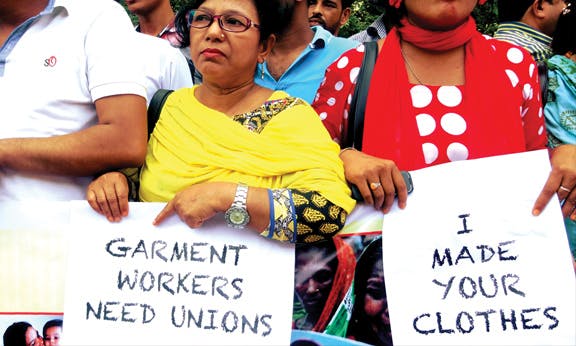Three years since Rana Plaza, garments workers’ demands still not met

Bangladesh Student Federation activist Jaheen Faruque Amin was one of thousands of volunteers who sorted through wreckage looking for survivors and bodies after the collapse of Rana Plaza on 24 April 2013.
“What else can I say? I have seen films on Auschwitz, and Rana Plaza was our Auschwitz … Injustice is still there for garments workers”, he tells Red Flag.
Located in Savar Upazila, one hour north-west of the capital, Dhaka, Rana Plaza was an eight-storey building containing five ready-made garments (RMG) factories and constructed on swampy ground.
Its owner, Sohel Rana, had fled and was arrested four days after the collapse. A leading member of the Jubo League youth wing of country’s ruling Awami League, Rana is now in prison awaiting trial.
On the day of the collapse, garment workers were forced to continue production despite visible cracks opening in the walls. As a result, 1,138 were killed and more than were 2,000 injured.
If their workers had more of a voice, they might have been able to resist managers who ordered them to work in the doomed building a day after large cracks appeared in it.Monir Hossain, a firefighter, pulled survivors from beneath the pancaked floors. He told US news outlet NPR, “The memories of those who cried for help … still haunt me … I’ve never seen scenes of carnage like this. I saw workers dying one after another, as they were trapped under fallen pillars or debris. I was so overwhelmed I had to be hospitalised with mental problems”.
On the third anniversary of the disaster, thousands protested in Savar outside a state graveyard where hundreds of unidentified victims are buried. Protesters laid water hyacinth flowers, recited prayers, demanded convictions and called for improved safety standards at Bangladesh’s 4,500 RMG factories.
“Three years have passed and still we don’t see any justice. No one has been held to account for one of history’s worst man-made disasters”, union leader Abul Hossain told the demonstration.
Police arrested 41 officials who allegedly declared the structures safe. Twenty-four of them have since absconded and there have been no convictions.
Last year, authorities compensated 3,000 victims, including injured workers and families of the deceased. But many say it was insufficient. “I got 4,000 [T]aka … (A$67) a month for two years. But now I don’t have anything”, Swapna Bibi told NPR. She had been trapped in the rubble for four days after the collapse.
Across RMG-producing countries, factories scramble to offer the cheapest production prices at the expense of workers’ rights. It is a race to the bottom. And Bangladesh is “winning”. The average RMG worker there is paid US$68 per month compared to US$280 in China.
In 2013-14, the country’s RMG industry – the second largest in the world – was worth US$24.5 billion, accounted for more than 80 percent of export earnings and employed 4.2 million workers, the majority of whom are women.
There have been some small improvements. Spontaneous and coordinated strikes and protests in the aftermath of Rana Plaza led to a 76 percent increase to wages.
European retailers also signed the legally binding Accord on Fire and Building Safety in Bangladesh, which covers more than 1,600 factories subcontracted by retailers such as H&M, Marks & Spencer and Primark. Many US companies joined the Alliance for Bangladesh Worker Safety.
Both agreements set out structural, electrical and fire-safety improvement plans.
Yet 70 percent of plans are behind schedule. “[The] Accord and Alliance are monitoring … buyers’ interests”, volunteer rescuer Moniruzzaman Masum told Red Flag.
In Rampura Thana (“city district”) in Dhaka, journalists reportedly found workers crammed elbow-to-elbow on the floor stitching tags of Western retailers into garments. The fire escape stairwell was blocked by a padlocked iron gate. The few fire extinguishers present had expired.
“Let’s remember that none of the factories operating in Rana Plaza had trade unions,” Human Rights Watch Asia director Phil Robertson recalls. “If their workers had more of a voice, they might have been able to resist managers who ordered them to work in the doomed building a day after large cracks appeared in it.”